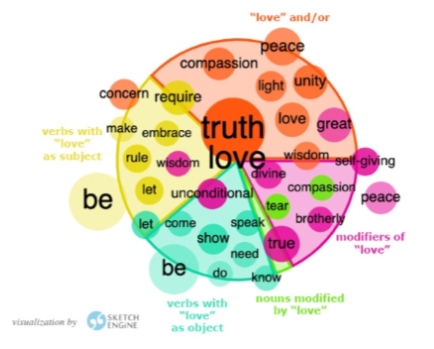Keith Wilson
Recently the news has, even more than usual, seemed to be full of sorrow and suffering. To provide a little contrast, I decided to pen (key?) a few words about love. This wasn’t a random choice. As some of you may know, I’m currently carrying out research at the University of Birmingham and Woodbrooke into whether the language used by British Quakers differs from that used by non-Quakers. Spoiler alert! What I’ve discovered to-date suggests that it does.
I won’t bore you with details, although I’ll gladly bore you interminably if you’re incautious enough to ask for further information. Suffice it to say that I’ve collected text from 2,900 articles published in The Friend and Quaker News between January 2000 and April 2020. After a lot of statistical faffing around, I’ve found that this text uses the word ‘love’ significantly more often than it is used in language more generally. That makes ‘love’, in linguistics jargon, a keyword.
Actually, ‘love’ isn’t on its own; I found another 145 keywords to keep it company. That’s topics for the next 12 years of articles for Forty-Three sorted! But let’s not get carried away; today’s word is ‘love’.
Quakers write a lot about love. Confirming this is gratifying but it might be more interesting to know what they say about love. I could write you an essay but, by feeding my text into a fascinating piece of software called Sketch Engine®, I can do something much more interesting. I can show you what Quakers are saying about love.
The graphic may look complicated, but it isn’t. Some words are a like magnets: they attract each other. If you read the word ‘peace’ for example, you wouldn’t be surprised to find the word ‘quiet’ nearby. Similarly for ‘water’ and ‘drink’.
The diagram simply shows words that, in my text collection, are attracted to ‘love’. The stronger the attraction, the closer the word is to the centre of the diagram; the more often the word occurs close to ‘love’ in the articles, the bigger the coloured blob it sits on.
Different grammatical relationships are identified with different colours, and blobs of a particular colour are loosely collected into sectors. To improve readability, the sectorisation is somewhat random, so it’s best to use the colours as a guide.
If you’re so inclined, you can make your own interpretations of the graphic. You probably won’t be surprised, for example, that ‘love and truth’ is the strongest and most frequent relationship, nor that ‘divine’ and ‘love’ are strongly related. But why do ‘true’ and ‘love’ have a more distant relationship? And is it only me that finds it interesting so see a strong relationship between love and wisdom?
What’s the conclusion? How about “Quakers write a lot about love, and they write about it in many contexts”? In other words, it looks like we Quakers love to love – which surely can’t be such a bad thing in today’s troubled world.
*Apologies to Tina Charles!
| Previous Article | Next Article |
Back to July 2022 Newsletter Main Page
Forty-Three Newsletter • Number 519 • July 2022
Oxford Friends Meeting
43 St Giles, Oxford OX1 3LW
Copyright 2022, Oxford Quakers

